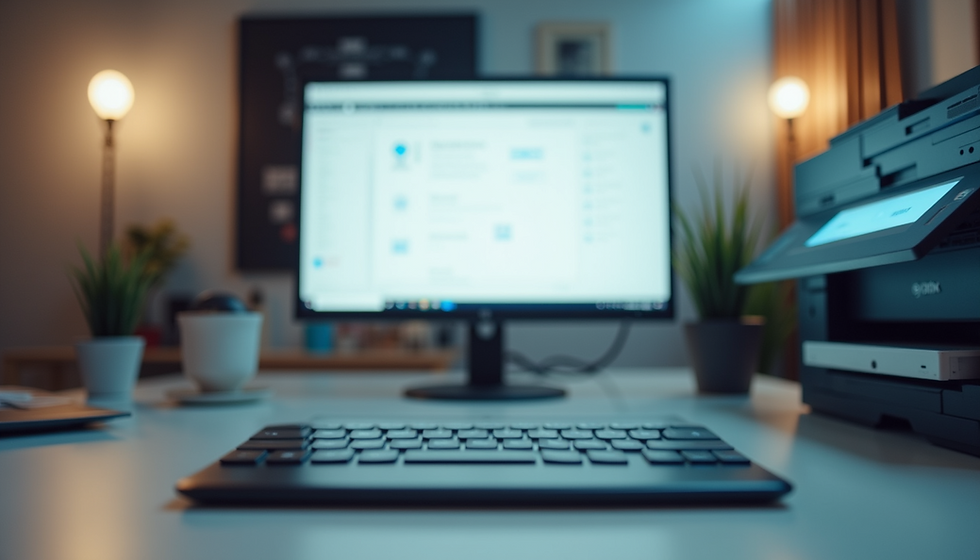Understanding Common Issues with Digital Equipment
- Brad Blackmon
- Jun 7
- 4 min read
In today's technology-driven world, digital equipment plays a crucial role in both personal and professional settings. Whether it is a printer, a computer, or a digital camera, these devices enhance our productivity and creativity. However, like any machinery, digital equipment is prone to common issues. Understanding these problems can save you time, money, and frustration. This blog post will examine the most common issues with digital equipment and provide practical solutions.
Common Issues with Digital Equipment
Digital equipment can present a variety of challenges, ranging from hardware failures to software glitches. These problems can lead to significant downtime and hinder performance. Let’s dive into some of the most common issues you might encounter with your digital devices.

1. Printing Problems
One of the most frequent issues users face is with printers. Problems such as printer jams, error messages, or failure to print can be incredibly frustrating. Here are a few common causes and solutions:
Paper Jams: This usually occurs when the paper is not loaded correctly or when there are foreign objects inside the printer. To resolve this, always load the paper properly and regularly clean the feeder area.
Low Ink or Toner: Running out of ink or toner can halt your printing tasks. Regularly check your ink levels and keep replacements on hand to avoid interruptions.
Driver Issues: Sometimes, the printer may not communicate with your computer due to outdated or incorrect drivers. Ensure that you install the latest drivers from the manufacturer's website.
2. Computer Glitches
Computers are essential tools in our daily lives, yet they can encounter various glitches. Here are some common computer problems and ways to fix them:
Slow Performance: If your computer is running slowly, it could be due to too many background applications or a lack of storage. Try closing unused programs and uninstalling unnecessary files to enhance performance.
Overheating: Computers can overheat due to dust buildup or a malfunctioning fan. Regularly clean out your computer’s vents and ensure the fan is functioning correctly.
Software Crashes: Software applications can crash unexpectedly, which may result from incompatibility or bugs. Keeping your software updated can significantly reduce these occurrences.

3. Networking Issues
As our reliance on Wi-Fi networks grows, connectivity problems have become increasingly common. Here are some tips to troubleshoot networking issues:
Slow Internet Connection: This can result from various factors, including network congestion or ISP problems. Restarting your router and checking for updates might resolve the issue.
Wi-Fi Drops: If your connection drops frequently, check if other devices are experiencing the same problem. If so, consider relocating your router for better signal coverage.
Firewall Restrictions: Sometimes, firewalls can block necessary traffic, causing connectivity issues. Ensure your firewall settings allow the applications you want to use.
4. General Maintenance Tips for Digital Equipment
Taking care of your digital equipment is essential to prolong its lifespan and maintain optimal performance. Regular maintenance can prevent many of the problems mentioned earlier. Here are some tips to keep in mind:
Regular Updates: Make sure to keep your software, drivers, and firmware updated. This ensures you benefit from the latest features and security patches.
Physical Cleaning: Regularly clean your devices. Dust and debris can hinder functionality, so invest in cleaning supplies suitable for electronics.
Utilize Professional Services: For issues beyond basic maintenance, consider using professional services. For example, if you’re experiencing persistent problems with your printer, look into copier repair services to get expert help.
Troubleshooting Techniques
Sometimes, troubleshooting issues on your own can feel overwhelming, but following a systematic approach can help. Here are some effective troubleshooting techniques:
Identify the Problem: Take note of your equipment’s symptoms. Write down error messages, unusual behavior, or any patterns you’ve observed.
Research: Search online for similar issues. Forums, FAQs, and support groups can be invaluable resources for finding solutions.
Test Solutions: Once you’ve found potential fixes, test them one by one. Keep track of what works and what doesn't to streamline the process.
Seek Help: If all else fails, don’t hesitate to contact customer support. They can offer guidance specific to your equipment model.
By following these steps, you can often resolve issues on your own without needing professional assistance right away.
Staying Prepared
Preparedness goes a long way in mitigating the impact of potential equipment failures. Here’s how you can stay ready:
Keep Manuals Handy: Always have the user manuals for your devices accessible. These often contain useful troubleshooting sections.
Backup Data: Regularly back up essential files from your computer, camera, or any device. Use external hard drives or cloud services to safeguard your information.
Inventory Supplies: Maintain a small stock of necessary supplies like printer ink, batteries, and cleaning materials. This can prevent delays when you need to replace items quickly.
Final Thoughts on Digital Equipment Care
Understanding the common issues with digital equipment and knowing how to address them can enhance your productivity and prolong the life of your devices. Taking proactive measures, such as regular maintenance and seeking professional help when needed, can save you time and frustration in the long run. Whether dealing with printers, computers, or cameras, staying informed is key to ensuring your devices operate smoothly.
By implementing the strategies mentioned in this article, you can avoid common pitfalls and get the most out of your digital equipment. Don’t forget to celebrate the role technology plays in your life, making your tasks easier and opening new avenues for creativity!




Comments